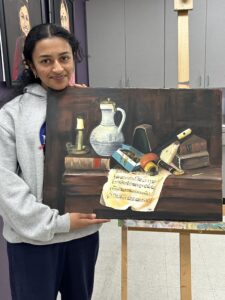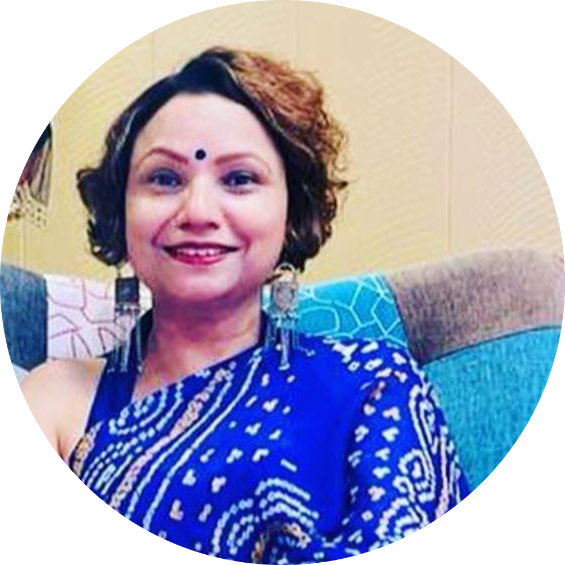Happiness is… Having Hot Pot
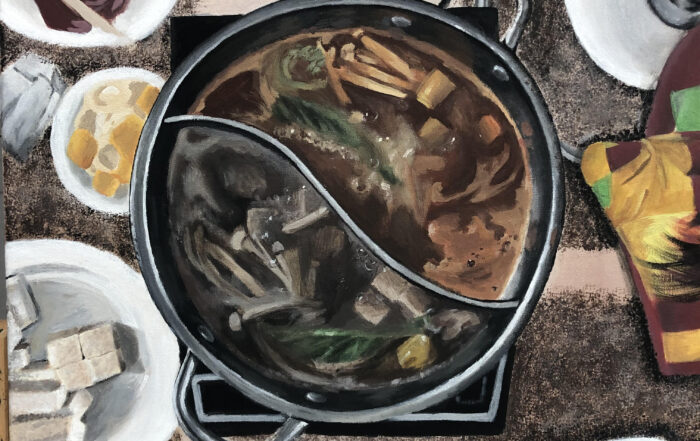
By- Vivian Gao, Senior 2023 Food has always brought people together, and my family is no exception. Family meals provide an opportunity for family members to come together, strengthen ties and build better relationships. In our busy lives being together with family for food is really important, as old tradition used to be. In my acrylic painting, the composition is centered around the pot, reflective of how it brings my family together and gives us a chance to take a moment from our busy lives to enjoy each other’s company. Hot pot is a well-known Chinese dish, and we eat it for special occasions and holidays; it’s our version of a Thanksgiving turkey. For this painting, I have used the acrylic painting technique of layering. The beauty of acrylic paint is that it dries fairly fast (unlike oil paint). This means that you can paint a layer of acrylic on the canvas, wait for it to dry, then paint another layer over top. This method gave depth and richness to my detailed food painting. The project was Still life with a combination of observational drawings. For this I prepare the meal laid the table and planned my artwork. I’m so happy with the outcome. Instances like this become memories I recall fondly, and paintings like this show my appreciation for the opportunities I have to spend time with the people I love. I hope the viewer is filled with warmth or a newfound appreciation for the little moments in their life.
Changing Our Wiring
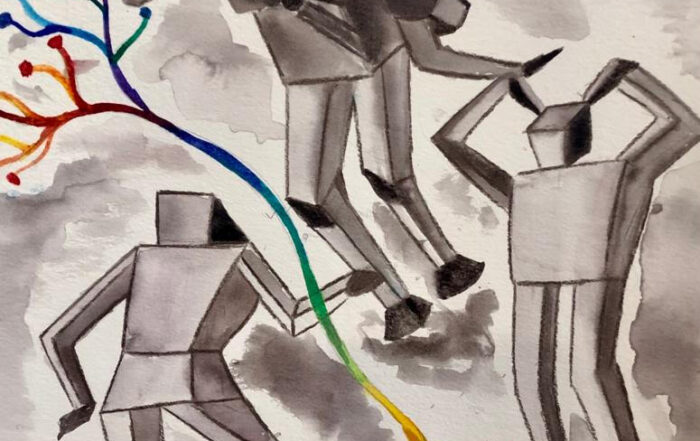
By Saesha Sharda, Sophomore, 27 November 2021 Humanity does not have a lack of struggles, and nowadays chaos is dissociating into different parties, groups, and movements. Sometimes, it is important to take a step back and think about the basic things required to clear the chaos, and that is exactly what my artwork focuses on. I made this artwork for the Reflections Art contest 2021 for which I was awarded Merit of excellence. This art was an abstract representation of my thoughts. I chose watercolors and handmade paper as a medium. In my artwork, there are 4 beings shown in a setting of chaos. There are two beings pictured in the middle arguing, causing a ruckus. Being at the top, however, is productive and carries a friend across the crisis. Also pictured in the artwork is a neuron. The way neurons communicate is by passing on a message from the ends of the neuron, called axons. The arguing beings are not near the axons and therefore are not able to receive the message that is being relayed. Therefore, they are arguing, causing even more spread of confusion and chaos. The beings at the top, however, can receive that knowledge and are able to channel their love and empathy towards helping those who are struggling in the crisis. My artwork shows that the passage out of the crisis is through human compassion and that the ignorance of information does the opposite. Take for example the battle for LGBTQ+ rights around the world. Countless studies have shown that being queer is not a choice and that individuals in the LGBTQ+ community do not deserve to be discriminated against. This aspect represents the logical component. We can also listen to and learn from the experiences of LGBTQ+ individuals and empathize with their struggles. This aspect represents the empathetic component. Bigots who despise individuals of the LGBTQ+ community ignore the information, which leads to assumptions and the spreading of hate. We must clear the chaos by collectively looking at information and empathizing with others; We must change our wiring.
Why do I Matter, coz I believe

By- Aditi Manchanda, Grade 8 This is my artwork from the Virtual Reflections Art Competition that was held during the month of October. The theme for this contest was “Why do I Matter”. The first thing that I did was make the head into a light bulb. This is the main portion of the focus of the topic “Why do I Matter”. I matter because I want to grow up and share my ideas with the world to make it a better place. This part of my art represents my ideas. One idea that I would like to spread awareness about equality. There are so many people in this world who get discriminated against because of the color of their skin, or their religion, or even because of their gender. They don’t get many opportunities that others do just because of their appearance or what they believe in. Because of all of this commotion, there are so many innocent people who get harmed. There is so much violence, protesting, and war especially with all the riots and chaos in 2020. This is why inside of the light bulb I wrote the word peace and made some scenery around it. I chose to make this piece because I love to draw fashion figures and wanted to incorporate that into my artwork. I made this figure sitting down with a red top and blue jeans. This part of my art represents me. I used colored pencils and a black pen (to trace) to complete my artwork. If used by themselves, colored pencils are used in two techniques – layering and burnishing. Layering is a technique usually used at the beginning of the drawing. Its idea is to use primary colors in layers and with that to get different tones. Burnishing is done on layers and for that is used a colorless blender or a light-colored pencil. For my artwork I used layering. I used this technique for the background in my light bulb. I just used one layer of color for the skin, clothes, and the mountains of my picture. Finally, I used brown paint to make the ledge that my figure is sitting on. The paint I used was acrylic. I hope that this was informative and encouraged you to support causes to make the world a better place. Thank you! — Aditi Manchanda Grade 8
Celebrating Colors with Mother Teresa
By Arjun Anand, Grade 8th Many people have heard of Mother Teresa. She was a nun who helped “the poorest of the poor.” She did so in Calcutta, India, for most of her life. Many admired her for her charitable work. The painting I made honors her, and the services she did in her lifetime. For this painting, I used Cubism as my main technique. Some famous cubist artists are Piet Mondrian and Salvador Dali. Cubism was prominent in the early 20th century, and it was pioneered by Pablo Picasso and Georges Braque. In cubist art, objects are analyzed and broken up and reassembled in an abstracted form. To me, cubism represents the idea that not everything is perfect and that they don’t have to be perfect to look good. In my drawing, I added many different colors to show uniqueness. I also added small details, such as earrings, which reminded me of my mom. To honor Mother Teresa, I drew blue stripes running across the drawing. The stripes represented the blue stripes on Mother Teresa’s sari. A sari is an article of traditional clothing that women wear in India. To do this drawing, I used many tools and techniques. I started off by penciling in the basic lines and shapes. To make my lines for my cubes straight, I used a ruler. Once I was done with that, I used a 0.1 black inking pen to ink the drawing. Now, the basic drawing was done, I just had to color the rest. To do that, I used Copic Brush Markers to color the drawing. I colored each square a different color. In the end, I was happy with the result.
Village Scene, Warli Art
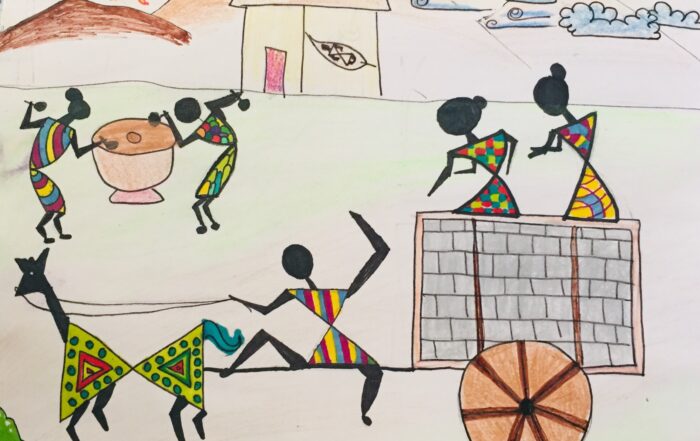
By, Minali Kancharla, Grade 7th The word Warli means a piece of land in the Varli language. Warli is a folk painting style native to India that mostly represents traditional everyday living and special events. The Warli style uses geometrical designs to make the main body of the subjects, this is for humans and animals. Warli painting uses basic shapes such as circles, triangles, and squares. The first step to this art is to sketch out your village scene using a set of basic shapes and make geometric patterns on the dresses. The page was then washed with tonal watercolor, to give a vintage effect. After the water wash on the page dries up, I outlined the sketch with a black point pen. The color scheme chosen for this artwork was Split complimentary, for this I chose two sets of split complementary colors. For each animal or human, use one set of complementary colors to fill the designs inside the subject. The end result is a colorful piece of art made from basic geometric shapes and colors.
Chaos in Oneself
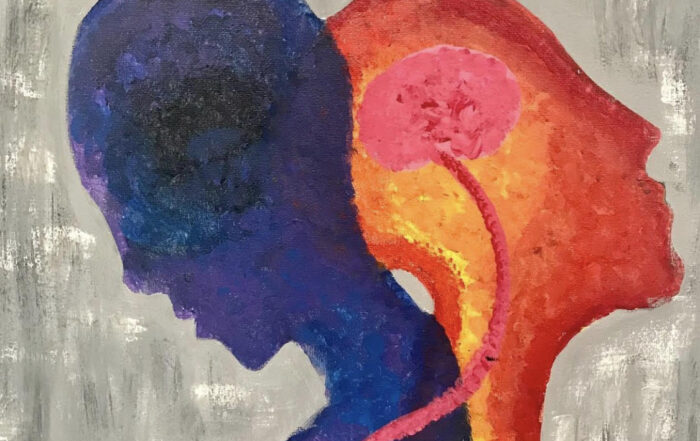
By- Saesha Sharda, Freshman, 2020 “Life doesn’t make any sense without interdependence. We need each other, and the sooner we learn that the better for us all.” — Erik Erikson In the present artwork, I have chosen to write focuses on the struggles of having bipolar disorder. Bipolar disorder is a mental illness characterized by extreme swings of high and low moods. The high mood is known as the manic phase, and the low mood is known as the depressive phase(“Bipolar Disorder: Symptoms, Causes, Diagnosis, Treatment.”). In my painting, I have shown two human-resembling figures balancing on each others’ backs, connected by the brain and heart. One figure is blue and has a heart painted on its chest. This figure represents the depressive phase, as blues and purples usually represent sad, somber moods. The other figure, which is yellow and has a brain painted in its head, represents the manic phase, as we normally pair the color yellow with high energy. The reason the heart and brain are shown is to represent their connection: Rational thinking (the brain) and Emotions (the heart). The figures are part of the same person, symbolizing how the two phases occur to the same person, affecting the same person, making it especially hard to get through daily life. The reason I wanted to create this painting was that I am passionate about raising awareness about not only bipolar disorder, but mental health issues in general. It is so important that we spread the word about mental illnesses and coping with them so that we can break the stigma that surrounds them. Stigma is a word to describe the social disapproval or discrimination against a person based on their characteristics, physical or mental. It is the fear of the stigma that keeps people suffering from mental health issues from coming forward about their struggles. In the Indian community especially, stigma against mental health issues is very apparent. The more we talk about it, the closer we are to helping someone cope with their mental illness and even saving lives. Submitting my painting to Vosap’s International Competition about disabilities was the perfect opportunity to share my art, and spread awareness about mental health issues. Work Cited: “Bipolar Disorder: Symptoms, Causes, Diagnosis, Treatment.” WebMD, WebMD, www.webmd.com/bipolar-disorder/mental-health-bipolar-disorder#:~:text=Bipolar%20disorder%2C%20also%20known%20as,sad%2C%20hopeless%2C%20and%20sluggish.
Periodt…! periods are not our weaknesses, but our strengths
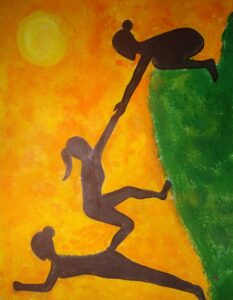
By -Saesha Sharda, Grade 9th When I was a little girl, I was not really encouraged to talk about menstruation, especially in front of my older family members and relatives. Not only was I confused about why periods occur, but also why I wasn’t allowed to talk about it. Now that I’m older and know about periods, I can comfortably talk about them with my parents whenever I have questions or concerns. Menstruation is a fascinating process that happens to almost every single woman on the planet, and I don’t understand why women get shunned for talking about it. Periods are not ‘gross’ or ‘weird’, they’re pretty cool. We need to empower women and encourage them to stand up and talk about light-hearted things like periods, to other heavier topics. My artwork on women empowerment ties into the concept of women helping women. In my artwork, I have shown three women helping each other climb a cliff through a fire. The cliff represents the normal hardships women have to go through, and the fire represents how the outside world makes it harder for women to achieve these tasks. I have used acrylic paint to show a silhouette of the women the background is with acrylic textures. It is important we address things like this through artforms for expressions, I feel it is a step in the right direction. Women are awesome! But, I do understand that the older generation was raised to not talk about women’s’ issues and menstruation, but it is time that changes. Our periods are not our weaknesses, but our strengths; and it’s pretty cool that we get to go through this cycle that perpetuates the entire human species!
Art for improving Hand Dexterity for Children

“The hands are the instruments of man’s intelligence”, – Maria Montessori. children’s dexterity is so important in their education and for their overall development. art has great role to play in this regard. Arts helps in refining hand dexterity help children develop their cognitive, social and motor abilities. Art plays major role in developing following areas: Cognitive abilities: Art teaches students that mistakes are alright and not end of the problems but can be redone. Art induces the mind to discover. It teaches young minds that any problem may have more than one solution. Art gives learning and the power to make their ideas come true through materials Social abilities: Teach them that they have to endure efforts. It nurtures the social skill that they should value the efforts of others. Art study works as therapies for children with difficulties. Creative processes are a way to create an integration in groups with various cultures. Motor skills: Fine motor skills are those that involve a refined use of the small muscles which control the hand, fingers, and thumb. Handling a pencil or brush correctly, using glue to stick, paper, feathers, glitter, and the like on a mask and drawing improve the children’s dexterity and their use of objects in a controlled way. It is an excellent way to develop eye-hand coordination. Any activities that include crafts or playing with loose parts will help kids develop hand dexterity. Every art lesson in Kalaa is created keeping the development of the child’s social, cognitive, emotional, and physical development in mind. The skills developed during the process of creating art will enable your child to meet with future success in school and life.
Pleasanton Landscape, My City My home
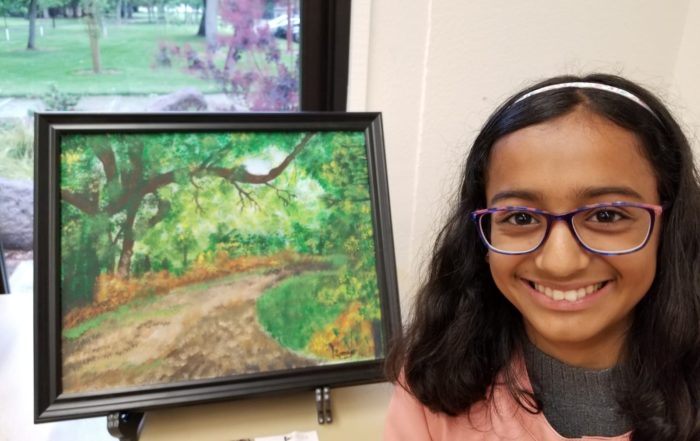
By Apoorva Kulshreshtha Pleasanton has many beauties. It has joyful downtown, the hiking trail called the Ridge, and a wonderful history. I painted a scene from the Ridge. It has trees and a trail. In my painting, there is a dusty pathway in the middle, trees in the distance and the front, some grass, and bushes of a variety of color. My painting included a bit of stipiling for the tree leaves, bushes, and the trail. My painting took a short amount of time. It was also my first painting I made in Kaala Art and Design. It was for the 2019 Kalaa Art and Design Exhibition. I like this painting because it has many different techniques in it and it has nature in Pleasanton. This painting is inspired by the artist, Vincent van Gogh. He was famous for post impressionists and the painting “The Starry Night”. Van Gogh died in 1890. I really like his artworks since the colors express how he is feeling in the painting and he makes landscape and people in his own style.
We are all the Same

Saesha Sharda June 18, 2020 The recent movement of Black Lives Matter has shed light on many prejudices and racial biases. It is also June, pride month, which is a time to support LGBTQ+ individuals. This compelled me to take a stand and talk about it. I created an artwork that combines the two worlds to spread awareness and love. People of color are heavily oppressed in the United States due to racial biases and white supremacy. Similarly, individuals who are part of the LGBTQ+ community are prejudiced and are oppressed. They are denied jobs, healthcare, and sometimes a proper shelter to live in. We are all equal; we are all human. We deserve the same treatment. Our history has had some great moments, but it has also had its fair share of terrible moments. We should take those events and learn from them so that we can never make those mistakes again. This artwork was inspired by cubism. Ther are different skin tones shown on one human being. The background has rainbow colors that represent LGBTQ+ pride. All the colors in this world make the perfect picture. My artwork portrays how we are all the same regardless of race, ethnicity, gender, or sexual orientation. It is important to create art pieces like this so that we can spread awareness and learn from our mistakes. As a result of powerful protesting, the government has passed laws and made it a point to address issues like these. In fact, the Supreme Court recently stated that federal law will protect LGBTQ+ citizens from discrimination in the workplace. This has happened because of constant protesting from all 50 states in America. People need to know about the power of unity and how each and every individual is important in it. If we constantly clash and divide, we will get nowhere; in fact, we will help the oppressor. When we work together, we can make a big difference for the better.




